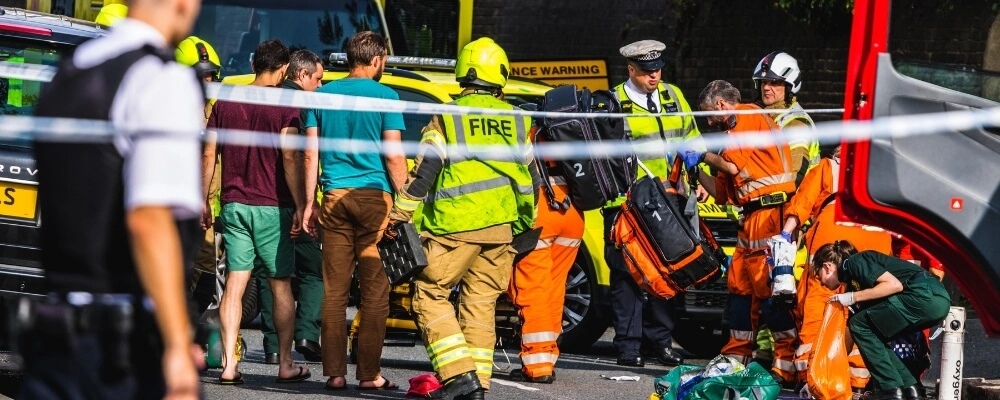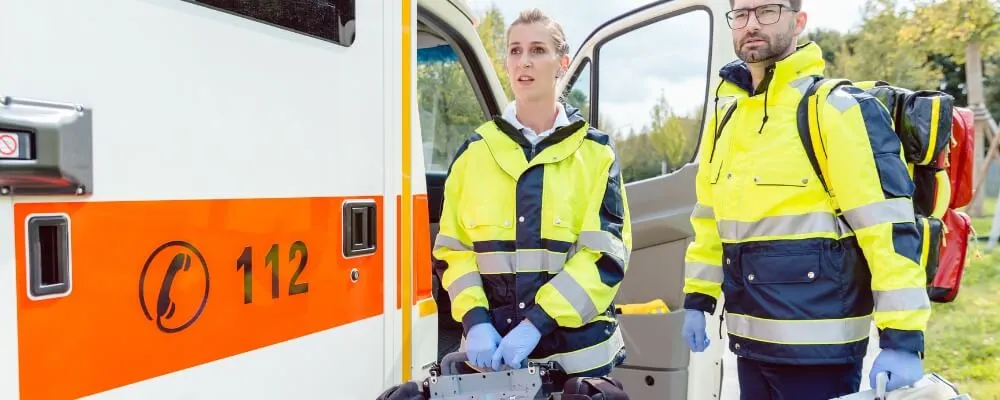Emergency Communication, at its core, is the structured system designed for the swift and efficient exchange of information during unexpected events or crises. In our rapidly evolving world, where natural disasters, technological disruptions, and unforeseen incidents can occur without warning, understanding the intricacies of emergency communication becomes paramount.
This blog delves into the essentials of this critical system, shedding light on its significance, components, and the pivotal role it plays in ensuring safety and coordination during emergencies. Join us as we navigate the world of emergency communication, a cornerstone of modern disaster response and management.
Definition Of Emergency
An emergency is an unforeseen situation or event that demands immediate attention and action. It can range from natural disasters like hurricanes and earthquakes to man-made events such as acts of terrorism or power outages. In these situations, the ability to communicate effectively becomes paramount to ensure the safety and well-being of individuals and communities.

What is Emergency Communication, And Why is it crucial?
Emergency communication is the system of rapidly transmitting vital information during crises, disasters, or unexpected events. It focuses on:
- Alerts and warnings: Notifying the public about impending danger (e.g., severe weather, natural disasters, security threats)
- Instructions: Providing guidance on protective actions (e.g., evacuations, shelter-in-place, medical advice)
- Coordination: Facilitating communication between first responders, government agencies, and the affected communities to streamline response efforts
- Public information: Sharing updates on the situation, available resources, and instructions to maintain public safety and calm
Why is Emergency Communication Crucial?
- Saves Lives: Timely and accurate information empowers people to make informed decisions that can protect themselves and their families.
- Reduces Chaos: Clear instructions and guidance help minimize panic and confusion, enabling an orderly and safe response.
- Enhances Response Effectiveness: Efficient communication between responders, agencies, and the public leads to better coordination and faster deployment of resources.
- Protects Property: Early warnings and instructions can help people take measures to mitigate damage to their homes and belongings.
- Promotes Recovery: Effective communication throughout the recovery phase helps communities access aid, rebuild, and return to normalcy.
What’s an Emergency Communication System?
An Emergency Communication System (ECS) is a structured and integrated network of technologies, protocols, and procedures designed to facilitate the rapid dissemination of critical information during emergencies, disasters, or security threats. It serves to promptly alert affected populations, provide clear instructions on protective actions, and streamline coordination between responders and the public.
Key Purposes of an ECS:
- Early Warning: Delivering timely notifications about impending dangers (e.g., natural disasters, chemical spills, active threats) to enable preventative measures or evacuation.
- Situational Awareness: Providing real-time updates on the evolving situation to support informed decision-making by individuals and authorities.
- Response Coordination: Establishing communication channels among first responders, government agencies, healthcare providers, and other stakeholders to optimize resource allocation and operational efficiency.
- Public Information and Guidance: Sharing essential instructions on how to stay safe, such as evacuation routes, shelter locations, and medical advice.
Essential Features of a Robust ECS:
- Redundancy: Incorporating multiple communication channels (e.g., sirens, mass notification systems, radio broadcasts, social media) to ensure message delivery even if primary channels fail.
- Accessibility: Providing information in multiple languages, formats suitable for individuals with disabilities, and considering cultural sensitivities to reach all segments of the affected population.
- Clarity and Brevity: Communicating in concise, unambiguous language that focuses on the nature of the threat, required actions, and sources of further information.
- Reliability: Establishing trust by using designated, authoritative sources to prevent the spread of misinformation and maintain public confidence.
- Speed: Prioritizing the rapid transmission of alerts and updates, as timeliness is often paramount to saving lives and minimizing damage.

What is 911 and Its Role In Case Of Emergency
The 911 system is the universal emergency access point in the United States, Canada, and portions of Mexico. It provides a centralized, easily accessible telephone number for individuals to quickly seek help during critical incidents. When someone dials 911, the call is routed to a geographically designated Public Safety Answering Point (PSAP) staffed by specially trained emergency dispatch personnel.
Key Functions of the 911 System
- Rapid Connection to Emergency Services: The primary goal of 911 is to establish an immediate link between individuals facing emergencies and the necessary first responders, like law enforcement, fire departments, and emergency medical services (EMS).
- Situational Evaluation and Triage: Dispatchers use systematic questioning to gather essential details, including the type of emergency (medical, fire, criminal activity), the exact location of the incident, and the caller’s name and contact information.
- Resource Allocation and Deployment: Based on the caller’s responses, the dispatcher assesses the situation’s priority and dispatches the most appropriate resources.
- Provision of Pre-Arrival Guidance: In some cases, dispatchers might offer instructions to help the caller manage the situation before first responders arrive. This guidance could include basic first aid, securing a hazardous location, or taking safety measures in the face of immediate danger.
Circumstances Warranting a 911 Call
Contact 911 for urgent medical crises (unconsciousness, severe injuries, suspected heart attack or stroke), active criminal offenses, fires and structural hazards, major accidents or vehicular collisions, or any situation that poses an immediate risk to life, health, or property.
Critical Considerations
- Composure during the Call: It’s vital to stay as calm as possible when speaking with a dispatcher to ensure clear and effective communication.
- Prioritize Location Awareness: Accurately identifying your location is essential. If you don’t know the precise address, provide descriptive landmarks or intersections.
- Adherence to Dispatcher Instructions: Follow the dispatcher’s guidance carefully and remain on the line until they tell you it’s okay to hang up.
Emergency Communication Services In Different Countries
Emergency communication services vary across countries, ensuring that residents and travelers can access help when needed. Here’s a brief overview of emergency communication services in different countries:
European Union (EU):
- In Europe, the emergency number is 112. Dialing this number from any EU country connects you to emergency services such as police, fire, and ambulance services.
- The call to 112 is free and can be made from any mobile phone, landline, or payphone. In most EU countries, the operator will speak both the local language and English.
- The Next Generation 112 (NG112) is a blueprint for emergency communications based entirely on Internet Protocol (IP) technology. It aims to provide a platform for innovative multimedia communications, ensuring that Public Safety Answering Points (PSAPs) are equipped to receive emergency communications from various devices and applications.
United States and Canada:
- The emergency number is 911. The NG 9-1-1 initiative aims to update the 911 service infrastructure to improve public emergency communications services. This initiative is based on the work of the National Emergency Number Association (NENA).
United Kingdom and Other Countries:
- The emergency number in the UK is 999. The Next Generation 999 initiative focuses on updating the 999 service to meet modern communication needs.
- In Australia and New Zealand, the emergency number is 000.
Other Countries:
- In South Africa, the emergency number is 10111.
- In India, the local equivalent to the US’s 911 emergency number is 100, but 112 also works on mobile phones.
- In South Korea, the emergency number from a mobile phone is 02-112.
- In Brazil, the number for police is 190, while the number for fire and medical services is 193.
Travelers are advised to check the emergency calling number of the countries they’ll be visiting before departure. It’s also essential to understand that response times and services available might differ from one’s local community.
For more detailed information on emergency telecommunications in specific countries, you can refer to the Federal Communications Commission and Wikipedia’s article on Next Generation 112.
Additionally, the ITU (International Telecommunication Union) supports its Member States in the development of National Emergency Telecommunications Plans (NETPs), assisting national authorities in ensuring the continued use of ICT networks and services during disasters.

Communications Services in Emergencies
In times of emergencies, effective communication is paramount. It ensures that the right information reaches the right people at the right time, facilitating swift and coordinated responses. Let’s delve deeper into the role of key agencies and the services they oversee during such situations:
Federal Communications Commission (FCC):
- Role: The FCC is a U.S. government agency responsible for regulating interstate and international communications by radio, television, wire, satellite, and cable.
- In Emergencies: The FCC plays a pivotal role in ensuring that communication systems remain operational during crises. They set regulations and standards that communication providers must adhere to, ensuring reliability and accessibility during emergencies.
Department of Emergency Communications:
- Role: This department typically manages and oversees the emergency communication systems at a local or state level.
- In Emergencies: They are directly involved in handling emergency calls, dispatching first responders, and ensuring that communication lines remain open and effective. They work closely with the FCC to ensure compliance with federal standards and regulations.
Key Communication Services:
- Wireless Device Capabilities: In today’s digital age, most people rely on mobile devices for communication. During emergencies, these devices become even more crucial. The FCC and the Department of Emergency Communications ensure that wireless networks can handle the surge in traffic during crises and that people can reach emergency services and receive alerts without hindrance.
- VOIP (Voice Over Internet Protocol): VOIP allows voice communications and multimedia sessions over the Internet. It’s an alternative to traditional phone lines, especially useful when those lines are down or overloaded. The overseeing agencies ensure that VOIP services remain operational and accessible during emergencies.
- Traditional Telephone Coordination: Despite the rise of digital communication methods, traditional telephone lines remain vital, especially for older populations or in areas with limited internet connectivity. The agencies ensure that these lines remain functional and that emergency calls made through them are routed correctly and promptly.
Objective – Strengthening and Unifying Communication Infrastructure:
- The overarching goal of both the FCC and the Department of Emergency Communications is to create a robust and unified communication infrastructure for the nation. This means ensuring that all the different communication methods (wireless, VOIP, traditional phones) work seamlessly together without any gaps that could hinder emergency responses.
- They also work on continuously updating and improving the infrastructure, incorporating new technologies, and ensuring that the system can handle the challenges of both current and future emergencies.
The combined efforts of the Federal Communications Commission and the Department of Emergency Communications aim to create a resilient, efficient, and comprehensive emergency communication system. Their work ensures that no matter the nature of the crisis, citizens can reach out for help, receive timely information, and stay connected when it matters most.

Emergency Communication for The Hearing-Impaired
For those with hearing impairments, there are specialized communication tools available. Service providers offer text messages, solar-powered devices, and other technologies to ensure that everyone, regardless of their hearing capability, can contact 911 or receive emergency alerts.
Different Emergency Communication Devices
- Cell Phones: Often used for voice calls and text messages to 911 or other emergency numbers.
- VOIP (Voice Over Internet Protocol): Allows users to place calls over the internet. However, it’s essential to ensure that your VOIP service can connect to the local PSAP.
- Solar-Powered Radios: Useful during power outages, these devices can receive emergency broadcasts.
- Wireless Devices: These can transmit data and voice, which is especially useful when traditional phone lines are down.
In conclusion, emergency communication is a vital aspect of public safety and national emergency preparedness. From the Federal Emergency Management Agency (FEMA) to the American Red Cross, various agencies and organizations work in conjunction to ensure that, in times of crisis, communication remains clear, effective, and accessible to all.


